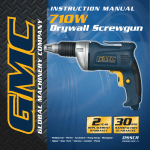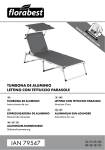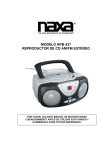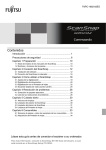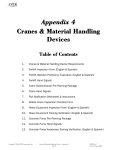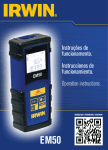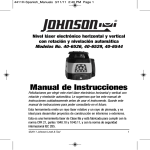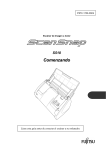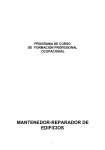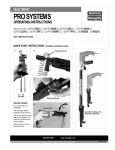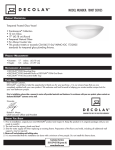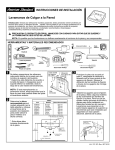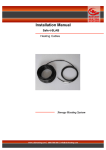Download ELECTRICAL TOOLS AND EQUIPMENT
Transcript
Appendix 23 Tools & Equipment 1. Tool & Equipment Requirements 2. Powder Actuated Tool Training Verification (English & Spanish) 3. Laser Training Verification (English & Spanish) Copyright © 2001 DPR Construction, Inc. Tools & Equipment - Appendix 23 Page 1 EHSP Rev 7 Revised August 2007 Tools & Equipment 1.0 Electrical Tools and Equipment The following section applies to all portable and plug-connected tools and equipment and the electrical tools, equipment and systems to operate them. 1.1 Portable Tools and Equipment The following general requirements apply to all portable and/or plug-connected tools and equipment: • Where wet /damp conditions exist, tools and equipment should be GFCI protected (including double insulated tools). • The non-current carrying metal parts of portable and/or plug-connected equipment should be grounded • Portable tools and appliances protected by an approved system of double insulation, or its equivalent, need not be grounded; where such an approved system is employed, the equipment should be distinctly marked • Each tool, cord and plug, and any equipment connected by cord and plug should be visually inspected before each day's use for external defects and indication of possible internal damage • Tools and equipment found damaged or defective should be removed from service and not used until properly repaired • Tools should not be carried by their power cord • Electrical tools and equipment should not be used in hazardous locations without prior approval and issuance of the appropriate work permit (i.e. Confined Space, Energized Electrical Work, Hot Work, etc.) by DPR project management, additionally; tools used in hazardous environments should be intrinsically safe. • All tools should be appropriate for the environment and hazards indicated • All tools and equipment should be unplugged prior to performing any alteration, maintenance or servicing operation such as cleaning and changing blades, bits or accessories • Appropriate guarding of all tools and equipment should be provided, maintained and used as per manufacturer’s guidelines • Where tools are used which present a “flying debris” hazard (grinding operations, chop saws, drilling overhead, chain saws, etc.), operators should use double eye protection, i.e., goggles and a face shield or a face shield with safety glasses; for additional guidelines on Personal Protective Equipment refer to the Personal Protection Equipment Appendix. 1.2 Extension Cords • Only heavy duty, three-wire ground extension cords should be used with portable electric tools and appliances. All cords should conform to the type and configuration required by OSHA standards • Minimum acceptable size of electrical cord is 12 gage, 3 wire, heavy duty • Cords should be protected from damage by doors, equipment, traffic, chemicals etc. • Cords should not be run down the middle of passageways, in stairwells and other paths of travel and a cord management program should be established on all projects • Whenever possible, all cords and cables should be elevated above the floor/ground a minimum of seven feet (7’); when elevating cords and cables, non-conductive fasteners should be used • Cords should be inspected daily before use for external defects such as deformed or missing pins or insulation damage and potential internal damage Copyright © 2001 DPR Construction, Inc. Tools & Equipment - Appendix 23 Page 2 EHSP Rev 7 Revised August 2007 • Damaged or defective equipment should be immediately removed from service, repaired and tested prior to being returned to service 1.3 Temporary Wiring • The electrical subcontractor is responsible for the installation, maintenance and testing of all electrical system components supplying power for the project, including all grounding references • All electrical work, installation and wire capacities should be in accordance with the pertinent provisions of the National Electrical Code, unless otherwise provided by applicable regulations, whichever is more stringent • All temporary wiring should be effectively grounded in accordance with the National Electrical Code • All switches should be enclosed and grounded • Panel boards should have provisions for closing and locking the main switch and fuse box compartment • Precautions should be taken to ensure that all open wiring is covered, secured and otherwise protected at all times • All 120 volt 15- and 20-amp receptacle outlets on the site that are not part of the permanent wiring of the building should use ground fault circuit interrupters • Cables passing through work areas should be covered or elevated to protect them from damage and to eliminate hazards to workers • Suitable means should be provided for identifying all electrical equipment and circuits, especially when two or more voltages are used on the same job • All circuits should be marked for the voltage and the area of service they provide • The only electrical circuits and outlets that should be utilized for construction power are those designated by DPR project management; red outlets, which are on the essential power circuits, are never to be used for construction power 1.4 Illumination Illumination should meet the following minimum requirements: Foot-Candles Areas of Operation 5 General construction area lighting. General low activity construction areas, waste areas, inactive storage areas, parking and field maintenance areas. Corridors, hallways, and exit ways. General construction plant and shops (e.g. mechanical rooms, electrical equipment rooms, fab shops, active store rooms, indoor toilets and workrooms.) First aid stations and offices. 3 5 10 30 1.5 Ground Fault Circuit Protection Ground fault circuit protection is the preferred method on DPR projects. Ground fault circuit protection is required at all branch circuits throughout the length of the construction project. Ground fault circuit interrupters (GFCIs) should be inspected and tested prior to use and at minimum monthly for continuity and proper functioning. Where construction tools and/or equipment will be plugged Copyright © 2001 DPR Construction, Inc. Tools & Equipment - Appendix 23 Page 3 EHSP Rev 7 Revised August 2007 directly into “house” power, a GFCI adaptor should be used between the construction tool/equipment and “house” power. In some cases an Assured Equipment Grounding Conductor Program may also be established on the construction site. An Assured Equipment Grounding Conductor Program will meet all federal, state and local requirements. For more information on the Assured Equipment Grounding Conductor Program refer to DPR Insight. This program will cover all cord sets, receptacles that are not part of the permanent wiring of the building or structure and equipment connected by cord and plug, which are available for use or used by all workers. 1.6 Fixed Equipment • Exposed, non-current carrying, metal parts of fixed electrical equipment, including motors, generators, frames and tracks of electrically operated cranes, electrically driven machinery, etc., should be grounded at all times • The path from circuits, equipment, structures, and conduits or enclosures to ground should: o be permanent and continuous o have ample carrying capacity to safely conduct the current likely to be imposed on it • Ensure that for all grounding circuits there is low enough circuit resistance between the ground and the grounded power conductor to allow sufficient current flow to interrupt the fuse or circuit breaker 1.7 Saws and Table Saws • Appropriate guarding of all saws should be provided and used • Guards and other protective devices should not be removed or rendered ineffective or inoperable • Power should be disconnected during all cleaning, maintenance or servicing of the saw, e.g., changing the blade, cleaning, oiling etc. • Ensure that the blade is properly rated and sized for the material being cut • Ensure that the blade is sharp • Ensure that two hands are utilized at all times • Ensure push sticks are used • Ensure that appropriate work benches, saw horses or areas are used for cutting operations; material should not be cut off the foot • Ensure that material is adequately secured prior to cutting • Ensure that appropriate guarding or barriers are used to guard against flying debris • Cut resistant trousers or chaps should be worn when using a chain saw • Chain saws should not be used without kickback protection on the chain 1.8 Grinders • Use and inspection of wheel and equipment should follow manufacturer’s guidelines • Appropriate guards of all grinders should be provided and used • Guards and other protective devices should not be removed or rendered ineffective or inoperable • Power should be disconnected during all cleaning, maintenance or servicing of the grinder, e.g., changing the wheel, cleaning, etc. • Ensure that the wheel is properly rated and sized for the tool and material being cut or ground Copyright © 2001 DPR Construction, Inc. Tools & Equipment - Appendix 23 Page 4 EHSP Rev 7 Revised August 2007 • • Ensure that material is adequately secured prior to grinding or cutting Ensure that two hands are utilized at all times 1.9 Drills, Screwguns and Impact Guns • Ensure bits and sockets are inspected and replaced routinely • Ensure tools are not forced beyond capacity • Ensure bits are sharp and the appropriate bit is selected for the task • Appropriate protective measures should be taken to protect against flying debris for overhead operations • Ensure tools and material are adequately secured 1.10 Woodworking Machinery All fixed, power driven woodworking tools should be provided with a disconnect switch that can be either locked or tagged in the off position. 2.0 Pneumatic Tools The following general requirements apply to all pneumatic or air powered tools on a DPR project: • All pneumatic tools should be secured to the hose in a positive manner to prevent accidental disconnection; all other hose connections should be secured to prevent accidental disconnection. • All air tools should be disconnected prior to altering, performing maintenance, cleaning, servicing, changing bits or accessories, etc. • Install and maintain safety clips or retainers on pneumatic impact tools to prevent attachments from being accidentally disconnected • All hoses and pneumatic equipment should be inspected regularly and before each use • All damaged hoses and pneumatic equipment should be removed from service and repaired to prevent failure • All hoses exceeding 1/2 inch inside diameter require safety devices at the source of supply to reduce pressure in case of hose failure • Hoses should be protected from damage by doors, equipment, traffic, chemicals etc. • Hoses should not be run down the middle of passageways, in stairwells and other paths of travel and a hose control program shall be established on all projects • Compressed air used for cleaning purposes should not exceed 30 psi, and then only in conjunction with effective chip guarding and personal protective equipment; exceptions to 30 psi are allowed only for concrete form, mill scale and similar cleaning operations • When using compressed air (or water) in cleaning operations or other operations which present “flying debris” hazards (blowing off pan decks, power washing etc.), operators should use double eye protection, e.g., goggles or a face shield with safety glasses • The use of compressed air to clean yourself or other workers is not permitted 3.0 Hand Tools 3.1 General Requirements • Only appropriate tools should be used for the job Copyright © 2001 DPR Construction, Inc. Tools & Equipment - Appendix 23 Page 5 EHSP Rev 7 Revised August 2007 • • • • • • • • • • • • • Appropriate personal protective equipment should be used at all times; refer to the Personal Protective Equipment Appendix for further guidelines Individuals should inspect hand tools prior to use Faulty or damaged tools should be removed from the site immediately Impact tools should be maintained free of mushroomed heads Proper body positioning and ergonomics should be maintained at all times Wooden tool handles should be kept free of splinters or cracks Tools should be routinely inspected to assure a tight connection between the tool head and the handle Wheelbarrows should not be pushed with handles in an upright position Wheelbarrows should have manageable loads and tires properly inflated at all times Pointed tools, such as chisels and screwdrivers, should never be carried point-up in any pocket, nor should they be carried point-down in a front pocket; they should be hand carried with the sharp edge or point away from the body, in a toolbox, bag, pouch or special tool belt Tools should never be carried in a way that interferes with a worker’s ability to use both hands while climbing a ladder or structure; tools should be raised or lowered by rope, using a bucket if necessary Tools should not be dropped, thrown or tossed to one another; they should be handed off carefully Refer to the Trenching & Excavation Appendix for further guidelines regarding hand tools and hand digging around utilities and services. 3.2 Specific Requirements 3.2.1 Axes/Mattock • Axes should be carried with their sheaths or guards in place, or at one’s side with the handle up and shank in the palm of the hand • Ensure that the head is securely fastened to the handle • Ensure the handle is free of cracks and splinters • Ensure that the blade is sharp • Ensure the axe is the proper weight and size for the task • Aim downswing of axe/mattock in a safe manner so as not to impact body 3.2.2 Chisels • Use the right size chisel for the job and a hammer of the appropriate weight • Ensure that chisels are sharp • Chisels that have begun to mushroom should be ground to avoid the danger of flying chips 3.2.3 Crowbars • Do not use substitutes such as pipes, iron bars or lumber to pry or fulcrum material • Ensure that the appropriate size of crowbar is used • Ensure that all body parts are out of pinch points and impact zones 3.2.4 Files • A file should never be cleaned by striking it against a metal object • Files should be equipped with handles • Files should not be used to punch or pry Copyright © 2001 DPR Construction, Inc. Tools & Equipment - Appendix 23 Page 6 EHSP Rev 7 Revised August 2007 3.2.5 Knives • Knives should be kept sharp to avoid the use of excessive force • Knives should always be carried with the blade away from the body • Knives are not to be used as screw drivers, pry bars or picks • Sheathed knives should be carried above the hip or in back, never in front • The use of pocket knives, Leatherman knives or other multi-tools is prohibited 3.2.6 Sledges and Hammers • Hammers should be replaced when the hammerhead begins to mushroom • Hammers should only be swung only as hard as is necessary and safe • Hit the target straight on, never at an angle • A hammer should never be used to strike another hammer; a soft mallet should be used instead to prevent chipping • Inspect all handles for cracks, splinters and looseness • Claw-hammers whose handles are not designed for continuous pulling should not be used for prying. Use a nail puller, ‘cats claw’ or prybar for this work • Sledges and hammers should be sized for the user 3.2.7 Shovels • Proper lifting techniques should be utilized when using a shovel • Twisting the spine should be avoided; the legs, rather than the arms, shoulders and back should be used • Use the ball of the foot instead of the arch to push the shovel • Inspect shovels for cracked, splintered or otherwise damaged handles • Ensure shovels are sharp to avoid excessive force being applied • Ensure the right type of shovel is used for the task 3.2.8 Wire and Bolt Cutters • Use the proper cutter for the job and ensure that the cutter’s capacity rating is not exceeded • Do not “rock” cutters • Cutters should never be used as pry bars or nail pullers • Cutters should have insulated grips and no wiring or conduit should be cut unless indicated safe to do so by an experienced competent person • Where the potential for contacting live electrical lines, tools must be insulated for the potential voltage, or appropriately insulated gloves should be worn 3.2.9 Wrenches • Wrenches should not be used when jaws are sprung to the point that slippage occurs • Wrenches should not be altered by the addition of handle-extensions or “cheaters” • Pipe or Stillson wrenches should not be used as a substitute for other wrenches 3.2.10 Drywall Finishing Tools • Ensure bazooka tubes and taping boxes are not overloaded and the appropriate size is used for the task Copyright © 2001 DPR Construction, Inc. Tools & Equipment - Appendix 23 Page 7 EHSP Rev 7 Revised August 2007 • • 4.0 Ensure tools are cleaned and maintained at all times, and adequate measures are taken to ensure floors and walkways remain clear of spills and slippery conditions Ensure vacuums on dust collection systems are appropriately grounded Powder Actuated Tools The following general requirements apply to all powder actuated tools: • Only trained employees should operate powder-actuated tools • Operators of powder-actuated tools should be trained in safe operation, specific to the tool being used • All powder-actuated tools should be inspected daily before use; damaged or defective equipment should be removed from service and repaired prior to use • Tools should not be loaded until immediately before use • Loaded tools should not be left unattended • Loads should be kept in separate and secure containers labeled "EXPLOSIVES - Authorized Personnel Only" • Spent loads and misfires should be placed in water containment for at least 24 hours prior to disposal • Signs should be posted in areas where powder-actuated tools are in use • In the event of misfires, the tool should be held against the work surface for 30 seconds before attempting another shot • Ensure that all people within 25’ of the operation are wearing appropriate eye protection 5.0 Lasers The following general requirements apply to all lasers used: • Only trained employees are allowed to operate lasers • Employees should wear proper eye protection where there is a potential exposure to laser light greater than 0.005 watts (5 milliwatts) • Beam shutters or caps should be utilized, or the laser turned off when laser transmission is not actually required • Lasers should be turned off if they are to be left unattended for a substantial period of time • All attempts should be made to set up lasers at a height sufficient to reduce exposure to other works in the area • Signs should be posted in areas where lasers are in use Copyright © 2001 DPR Construction, Inc. Tools & Equipment - Appendix 23 Page 8 EHSP Rev 7 Revised August 2007 Powder Actuated Tools Training Verification Archive Document – DO NOT DISCARD Name: Date: Jobsite: Equipment Company: Manufacturer(s) Model(s) Capacity(s) Training Only personnel trained in the safe use of powder actuated tools should be permitted to utilize this equipment. Training should be completed prior to using the equipment, and be specific to the equipment to be used. PPE & Signage Operators and bystanders should wear approved eye protection; some manufacturers recommend the use of safety goggles to protect eyes from flying particles. Operators and bystanders should wear hearing protection when using or in the general vicinity of powder actuated tools. Anti-vibration gloves should be worn with prolonged use and consideration should be given to tight confines and tool recoil as it relates to hand protection. Warning signage should be used in the work area to notify others of powder actuated tools in use. Tool Inspection: Tools should be inspected prior to use. Tools should be used with the correct shield, guard or attachment recommended by the manufacturer. Damaged or defective equipment should be removed from service and repaired prior to use. General Use Guidelines: Tools should not be loaded until immediately before use. Tools should not be altered or changed. Only manufacturer's compatible fasteners, loads and tool parts should be used. Verify the tool is not fully or partially loaded with a load or fastener prior to handling. Do not fire a tool without a fastener. Never place hand or other body part in front of the muzzle, as the piston and/or fastener may pass through the operator's body in the event of accident discharge. Point tool in a safe direction at all times. Do not close tool against work surface. Tool should be manually closed, with hand away from muzzle end to prevent unintentional discharge. Always hold tool perpendicular to work surface to limit the possibility of a fastener bouncing off the surface and striking operator or bystander. In the event you decide not to make a fastening after the tool has been loaded, always remove the load first, then the fastener. Never use powder actuated tools in an explosive or flammable atmosphere. Loaded tools and shots should not be left unattended, and must remain locked in a toolcase or toolbox when not in use. Loads should be kept in separate and secure containers labeled "EXPLOSIVES - Authorized Personnel Only". Spent loads and misfires should be placed in water for 24 hours prior to disposal. Test Fastenings & Material Compatibility: Test fastenings should be made with the lightest load level designed for use in the tool. If the lightest load does not set the fastener, try the next highest load level until the proper level is attained. This will eliminate the possibility of an overpowered fastener fully penetrating your work, thereby injury someone. Perform the center punch test if you are unsure of your fastening material. This will ensure the work can contain your fastening. Copyright © 2001 DPR Construction, Inc. Tools & Equipment - Appendix 23 Page 9 EHSP Rev 7 Revised August 2007 Tool should not be fired within three inches (3") of the edge of a concrete base material or within one-half inch (1/2") in steel. Do not attempt a fastening application closer to another previously inserted fastener, i.e., 3" in concrete, 1/2" in steel. (Refer to operator's manual for guidance.) Do not fasten into a concrete base material less than 3 times as thick as the fastener penetration unless otherwise permitted and never fasten into steel base material thinner than the fastener shank. Do not fasten into cast iron, tile, glass or other brittle materials. Do not fasten through pre-drilled holes. Do not fasten into a spalled area as fastener may bend and bounce off the spall and strike operator or bystander. Place fastener at least 3 inches away from spalled areas. Miss Fires In the event a load fails to discharge, the tool should be depressed for at least 30 seconds to ensure protection to operator or bystander in the event of a delayed load discharge; then the load should be removed, placed in water for 24 hours and disposed. Jammed, stuck or broken tools should not be unloaded or disassembled; improper handling may cause it to discharge, striking operator or bystander. Point the jammed tool in a safe direction; tag and lock up the tool and call your equipment vendor/supplier for assistance. This document hereby certifies that I have been instructed on the items listed above and I have had an opportunity to ask questions. I fully understand the DPR requirements for the use of powder actuated tools. Signature of employee Signature of person conducting verification review A copy of this form should be faxed to the DPR regional office PRIOR TO START OF WORK. Copyright © 2001 DPR Construction, Inc. Tools & Equipment - Appendix 23 Page 10 EHSP Rev 7 Revised August 2007 Verificación de la capacitación en herramientas accionadas por cartucho de pólvora Documento de archivo – NO DESECHAR Nombre: Fecha: Lugar de la obra: Compania: Equipo Fabricante(s) Modelo(s) Capacidad(es) Entrenamiento Solo se debe permitir que el personal entrenado en el uso seguro de las herramientas accionadas por cartucho de pólvora utilice este equipo. Debe cumplirse la capacitación antes de usar el equipo y ser specifico al equipo usado Equipo de protección personal y señalización Los operadores y los espectadores deben usar protección para los ojos aprobada. Algunos fabricantes recomiendan el uso de gafas de seguridad para proteger los ojos contra las partículas en el aire. Los operadores y los espectadores deben usar protección para los oídos cuando usen o se encuentren cerca de herramientas accionadas por cartucho de pólvora. Se deben usar guantes contra la vibración en caso de uso prolongado y se debe prestar especial consideración a los recintos cerrados y el efecto del retroceso de la herramienta en lo que se refiere a la protección de las manos Se deben usar carteles de advertencia en el área de trabajo para notificar a los demás que se están usando herramientas accionadas por cartucho de pólvora. Inspección de las herramientas: Se deben inspeccionar las herramientas antes de su uso. Las herramientas se deben usar con la protección, barrera o accesorio adecuados recomendados por el fabricante. Se debe quitar de servicio el equipo dañado o defectuoso y repararlo antes de usarlo. Guías generales de uso: No se deben cargar las armas hasta justo antes de su uso. No se deben alterar o cambiar las herramientas. Solo se deben usar sujetadores, cargas y partes de las herramientas compatibles con las del fabricante. Verifique que la herramienta no esté cargada total o parcialmente con una carga o con un sujetador antes de manejarla. No dispare una herramienta sin sujetadores. Nunca coloque la mano u otra parte del cuerpo en frente del orificio, ya que el pistón y/o un sujetador puede atravesar el cuerpo del operador en el caso de un disparo accidental. Apunte la herramienta en sentido seguro en todo momento. No cierre la herramienta contra la superficie de trabajo. La herramienta debe cerrarse con la mano lejos del orificio para evitar que se dispare por accidente. Siempre mantenga la herramienta perpendicular a la superficie de trabajo para limitar la posibilidad de que un sujetador rebote en la superficie y golpee a un operador o espectador. Si usted decide no disparar un sujetador después de haber cargado la herramienta, primero siempre quite la carga, luego el sujetador. Nunca use herramientas accionadas por cartucho de pólvora en una atmósfera explosiva o inflamable. No se deben dejar las herramientas cargadas sin supervisión. Los instrumentos y los disparos cargados no deben ser dejados desatendido, y deben quedarse encerró un toolcase o caja de herramientas cuando no en uso. Las cargas se deben guardar en recipientes separados y seguros rotulados "EXPLOSIVOS – Solo personal autorizado". Las cargas y balas usadas se deben colocar en agua durante 24 horas antes de desecharlas. Copyright © 2001 DPR Construction, Inc. Tools & Equipment - Appendix 23 Page 11 EHSP Rev 7 Revised August 2007 Prueba de sujetadores y compatibilidad del material: Los sujetadores se deben probar con el menor nivel de carga diseñado para el uso en la herramienta. Si la carga más liviana no fija el sujetador, pruebe con la carga que le sigue en nivel hasta que se obtenga el nivel correcto. Esto eliminará la posibilidad de que un sujetador sobrecargado penetre por completo en la obra y lastime a alguien. Realice la prueba del punzón de perforar si no está seguro del material del sujetador. De esta manera se asegurará que la obra pueda contener el sujetador. No se debe accionar la herramienta dentro de las tres pulgadas (3") del borde de un material de concreto o dentro de la pulgada y media (1/2") de material de acero. No intente fijar un sujetador cerca de otro sujetador insertado previamente, es decir, 3" en concreto, 1/2" en acero. (Consulte el manual del operador si desea una guía). No fije el sujetador en un material de concreto de menos de 3 veces el grosor de la penetración del sujetador, salvo que se permita lo contrario y nunca fije el sujetador en material de base de acero que sea más delgado que la espiga del sujetador. No fije en hierro fundido, losas, vidrio u otros materiales quebradizos. No fije a través de orificios pre-taladrados. No fije en un área fragmentada ya que el sujetador puede doblarse y rebotar del fragmento y golpear a un operador o espectador. Coloque el sujetador al menos a 3 pulgadas de las áreas fragmentadas. Cuasi disparos Si el disparo de la carga falla, se debe mantener la herramienta presionada durante al menos 30 segundos para protección del operador o espectador en el caso de una descarga demorada, luego quite la carga y colóquela en agua durante 24 horas antes de desecharla. Las herramientas atascadas, trabadas o rotas no se deben descargar o desarmar. El manejo indebido puede hacer que se dispare y lastime a un operador o espectador. Apunte la herramienta atascada en un sentido seguro, rotule y guarde la herramienta bajo llave y pida ayuda al proveedor/distribuidor del equipo. Este documento por el presente certifica que he recibido instrucción sobre los puntos listados anteriormente y que he tenido oportunidad de formular preguntas. Entiendo en forma cabal los requisitos de DPR con respecto a las herramientas accionadas por cartucho de pólvora. Firma del empleado Firma de la persona que realiza la verificación del repaso Se debe enviar por fax una copia de este formulario a la oficina regional de DPR ANTES DE COMENZAR EL TRABAJO. Copyright © 2001 DPR Construction, Inc. Tools & Equipment - Appendix 23 Page 12 EHSP Rev 7 Revised August 2007 Laser Training Verification Archive Document – DO NOT DISCARD Name: Date: Jobsite: Equipment Company: Manufacturer(s) Model(s) Capacity(s) Training Only personnel trained in the safe use of lasers should be permitted to utilize this equipment. Training should be completed prior to using the equipment, and be specific to the equipment to be used. PPE & Signage Operators and bystanders should wear approved eye protection; avoid direct eye exposure Warning signage should be used in the work area to notify others that a laser is in use. Tool Inspection: Tools should be inspected prior to use. Tools should be used with the correct shield, guard or attachment recommended by the manufacturer. Damaged or defective equipment should be removed from service and repaired prior to use. General Use Guidelines: Laser should not be altered or changed. Never use a laser in an explosive or flammable atmosphere. Lasers should not be left unattended. Use only the specifically designed batteries Store idle lasers out of reach from untrained persons Do not use optical tools i.e. telescopes, transits to view the laser beam Do not place the laser in a position which may allow someone to intentionally or unintentionally stare at the laser beam Turn the laser off when it is not being used Do not disassemble or attempt to repair the laser This document hereby certifies that I have been instructed on the items listed above and I have had an opportunity to ask questions. I fully understand the DPR requirements for the use of lasers. Signature of employee Signature of person conducting verification review A copy of this form should be faxed to the DPR regional office PRIOR TO START OF WORK. Copyright © 2001 DPR Construction, Inc. Tools & Equipment - Appendix 23 Page 13 EHSP Rev 7 Revised August 2007 Verificación de Capacitación en el uso de Láser Documento para archivo – NO DESECHAR Nombre: Fecha: Sitio: Compañía: Equipo: Fabricante(s) Modelo(s) Capacidad(es) Capacitación • • Sólo el personal capacitado en el uso seguro del láser estará autorizado para utilizar este equipo. Se debe cumplir la capacitación antes de usar el equipo, la que deberá referirse específicamente al equipo que se utilizará. Equipo de Protección Personal y Señalización • • Los operadores y transeúntes deben usar protección para los ojos y evitar la exposición directa a los ojos Se debe usar señalización de advertencia en el área de trabajo para notificar a los demás que se está usando un láser. Inspección de Herramientas: • • • Se deben inspeccionar las herramientas antes de usarlas. Se deben usar las herramientas con la protección, barrera o accesorio correcto, según las recomendaciones del fabricante. Se deben retirar de servicio los equipos dañados o defectuosos y repararlos antes de usarlos. Pautas Generales de Uso: • • • • • • • • • No altere ni cambie un láser. Nunca use un láser en una atmósfera explosiva o inflamable. No deje el láser sin supervisión. Use solamente las baterías diseñadas específicamente. Mantenga el láser que no esté en uso fuera del alcance de las personas no capacitadas en su uso. No use herramientas ópticas, como telescopios, tránsitos para ver el rayo de láser. No coloque el láser en una posición que pueda permitir que alguien, intencional o inadvertidamente, mire el rayo de láser. Apague el láser cuando no esté en uso. No desarme ni intente reparar un láser. Este documento certifica que he recibido instrucción sobre los puntos enumerados arriba y he tenido oportunidad de realizar preguntas. Entiendo completamente los requisitos de DPR para el uso del láser. Firma del empleado Firma de la persona encargada de la verificación Enviar por fax una copia de este formulario a la oficina regional de DPR ANTES DE COMENZAR A TRABAJAR. Copyright © 2001 DPR Construction, Inc. Tools & Equipment - Appendix 23 Page 14 EHSP Rev 7 Revised August 2007














